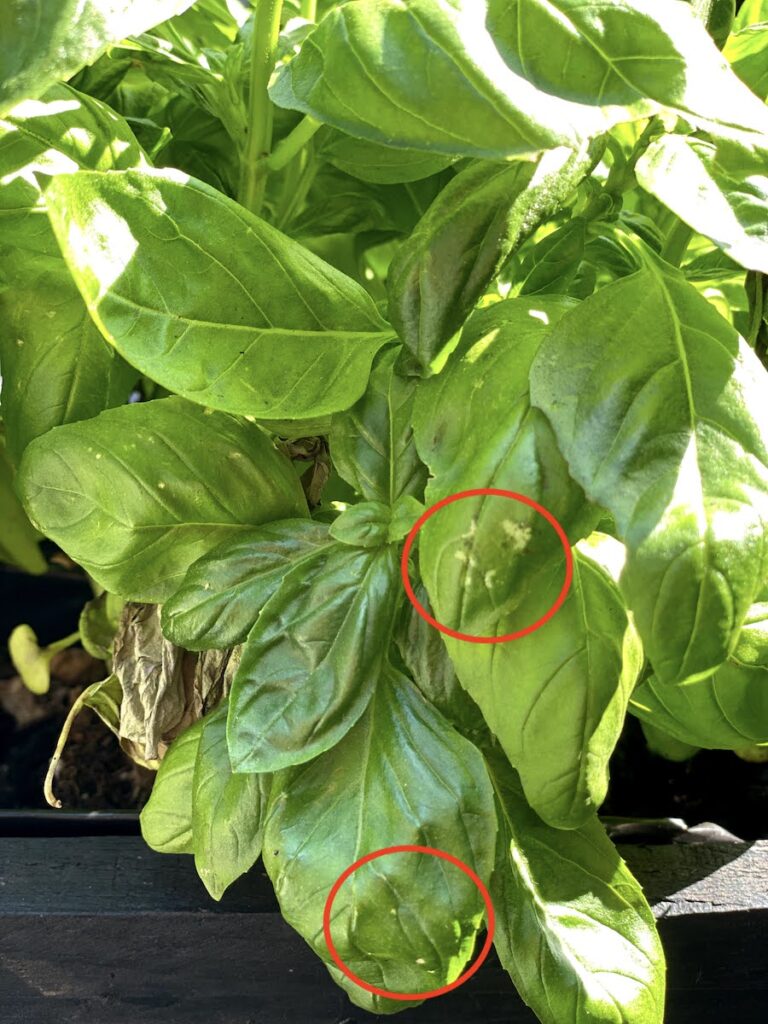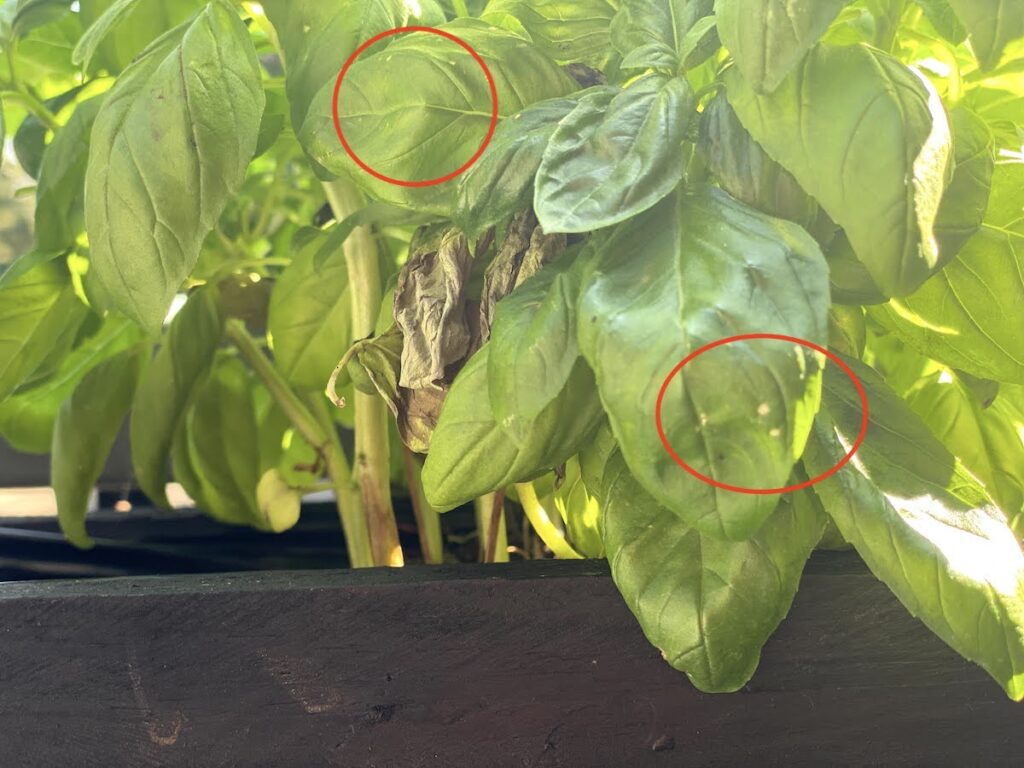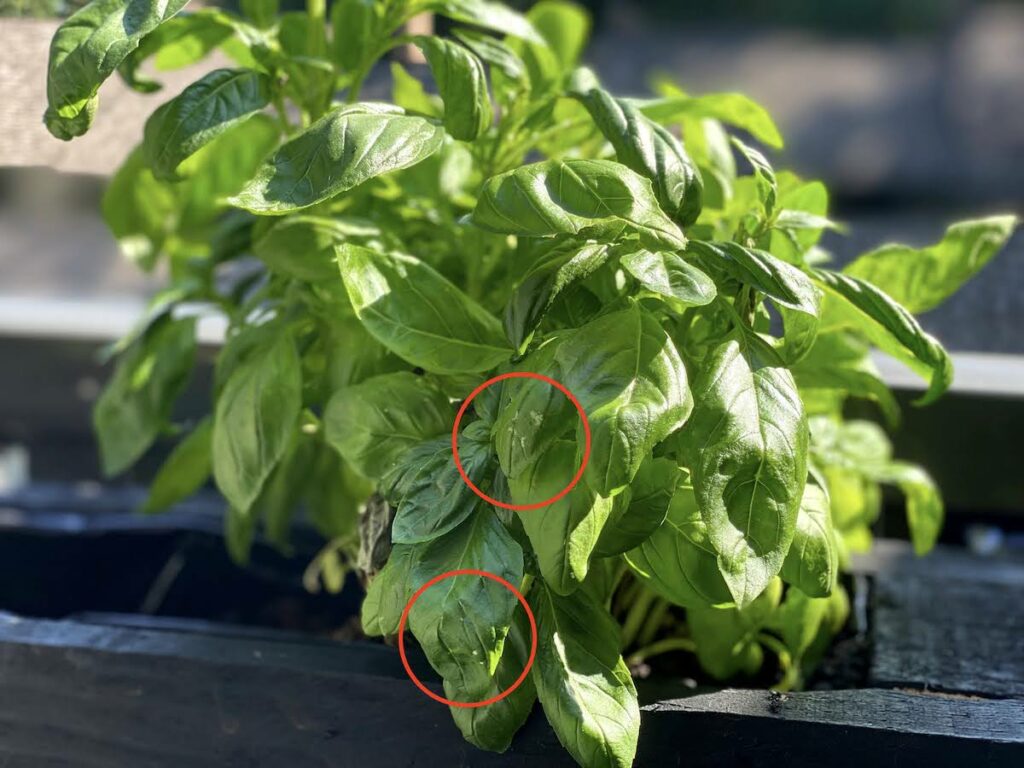As an Amazon Associate I earn from qualifying purchases. This website also participates in other affiliate programs and may earn commissions if you shop through the links used on this website.
(This article was originally published on July 11, 2022 and was last updated on September 4, 2022)
While basil plants are usually pretty easy to grow, occasional trouble does arise. If you’re dealing with white spots on basil plants, consider these 6 possible causes and remedies.

Growing any variety of basil (Ocimum basilicum) at home is a joy, and ensures you have a fresh supply of this delicious herb whenever you need it during the growing season (and even beyond, if you’re in a growing zone that lets basil grow as a perennial).
It is also relatively easy to grow and care for most of the time.
But whether you are an experienced gardener or just starting to dip your toes in, you will run into occasional plant trouble (including brown spots on your basil leaves, holes in the middle of the leaves or along the edges, wilting or otherwise drooping basil leaves, and more!)
One specific problem you may encounter is the development of white spots on your basil leaves.
While white spots on basil leaves can be concerning, you don’t need to worry. In most cases, there are easy ways to treat the basil leaves and save your plants.
Below, we will explore the most common causes of white spots on basil leaves. Once you identify the culprit, you can employ the appropriate remedy.
What Causes White Spots on Basil Plants?
There are two distinct categories of trouble you can run into with your basil plants – diseases and pest issues. If your basil has white spots, one of these is behind it – the trick is to figure out which.
As a general rule of thumb, you’re less likely to experience this problem if you’re growing your plants inside, but it’s not a given. Similarly, you always want to follow good growing practices to reduce the chances of problems: give your plants adequate space in their pots or in your garden (plant spacing), water correctly, ensure they have full sun, and take care of pests and diseases quickly.
To narrow down the source of trouble, take a close look at your plants. You will want to check both on top of the basil leaves and underneath on the infected plants. Take note of the size and shape of the spots on the infected leaves, as those will tell you a great deal about the underlying cause.

6 Possible Causes of White Spots on your Basil Leaves
Leaf Miners (Common Pests / Insect Infestation)
Just as their name suggests, leaf miners eat their way through leaves.
Unlike other pests, however, they do not leave holes. Instead, they leave white squiggly lines behind them as they travel, kind of like a contrail behind an airplane.
Leaf miners eat basil from within the leaf itself rather than on the edges. As they feed, they leave dead plant material in their wake.
While leaf miners do not damage the roots or overall growth of plants, they do damage the edible leaves. Obviously, as the prized part of basil is its delicious green leaves, they can severely impact your basil harvest.
There are two main species of leaf miners, ranging from ⅕” to a tiny 1/15” in size.
Predatory insects love feeding on leaf miners, so consider creating a welcoming environment for them. Unless you have a severe infestation, natural predators should control the problem.
Aphids (Common Pests / Insect Infestation)
These tiny pests love to collect on leaves and stems, sucking the sap out of them. Some species will even feed on plant roots. A soft-bodied insect, they are only approximately ⅛” long when fully grown. Their colors vary greatly and include white.
Aphids develop quickly, forming large colonies. Due to the size and density of the colonies, it may appear as though you have white dots on your basil leaves.
Typically, a quick shot of water from the hose will dislodge aphids. If you go this route, use caution spraying the water on the infected plant to avoid damaging your basil. This also doesn’t work on young seedlings, if you’re sowing from seed and have very young plants.
White Flies
Basil is not a favorite plant for most white fly species. But they love tomatoes (commonly planted near basil).
However, a few less commonly seen white fly species have a broader diet and could be problematic. Find out which species are common in your area to determine whether or not white flies are a pest to keep an eye on.
White flies are related to aphids, though much smaller. If you notice a white spot on the underside of your basil leaves, it is likely a cluster of white flies. They are easy to spot and will fly away after a gentle shake of the plant.
Powdery Mildew (Fungal Disease)
While not the most common disease to strike basil plants, powdery mildew can be a problem should it take hold. It is a fungal disease that thrives in moist, humid environments and often appears later in the season. A powdery mildew fungal infection is distinguishable by its white, circular spots on the leaves of plants.
When you spot powdery mildew, you should remove the diseased areas quickly to prevent spread. Use garden or kitchen shears to avoid damaging the rest of the plant, and be sure to dip your shears in soapy water in between cuts to avoid spreading fungal diseases.
While powdery mildew may not be transmitted by seed, it’s worth considering before letting it bolt (flower) and saving the seeds of a plant affected by the condition for next year. You also shouldn’t use an infected plant as a mother for a cutting.
What About Fusarium Wilt, Downy Mildew, and Bacterial Leaf Spot?
Several other fungal diseases target basil plants, including downy mildew, bacterial leaf spot, and fusarium wilt.
However, symptoms of these diseases present as yellow, gray, or black spots on basil – not white.
If your basil leaves have white spots, you can rule out these causes.
Nutrient Deficiency
Many gardeners jump to pests or fungal diseases when trying to diagnose the cause of white spots on basil plants. However, basil with white spots (as well as basil that is turning yellow) may also indicate an underlying problem in your soil composition.
Nitrogen deficiencies are a primary concern in gardens or containers. Basil loves nitrogen, so a deficiency here will dramatically impact the overall health of your plants.
If you are growing basil hydroponically, you may be facing a magnesium deficiency. A hydroponic garden is a wonderful alternative (or addition) to a traditional garden. However, without the mineral content often found in soil, you need to pay extra close attention to the nutrition your plants are getting.
Keep a high-quality liquid fertilizer on hand to provide nourishment to your basil.
How Can I Treat White Spots on a Basil Plant?

The information above will help you effectively “diagnose” the root cause of your basil leaves turning white. Once you have figured out the underlying source of spots on your basil, you can take action.
Treatment options will vary slightly based on whether you want a remedy for a disease infected plant or need pest management support.
Easy, DIY solutions are a quick and effective way to treat your basil plants. However, there are also store-bought products available should you prefer.
Disease
Some diseases spread quickly and easily, such as fusarium wilt. In these cases, the plant needs to be destroyed. Avoid replanting anything from the same family in the area for a few years to allow the soil to recover.
However, for many fungal infections, you only need to stop the spread of the fungal growth in its tracks.
Trimming the affected portion of the plant is likely all you need to do to save your basil – another reason regular pruning is a great idea for your basil plant’s health! Be sure you use clean tools, clean them well between cuts (dish soap and warm water will do), and change your clothes before handling other plants. The last thing you want to do is save your basil but spread fungal spores to other areas in your garden or containers.
Pests
The best way to handle a pest infestation is to hand pick the insects off the basil plant and dump them into a container of soapy water. Ideally, this should be done in early morning or during evening hours, as this is when most pests are active.
You will also want to treat the leaves to kill off any eggs and prevent re-infestation. There are two different ways to do so.
Store-bought options include neem oil and insecticidal soap. Both are best applied daily to combat the infestation. Don’t forget the underside of the leaf surface of impacted plants to address any eggs. Insecticidal soap has the added benefit of killing some pests when sprayed directly onto them.
If you prefer and have the time, there are some home remedies you can use as well. One particularly potent choice is a garlic and hot pepper spray. The strong scent deters most pests that will plague your basil plants. You can also opt for a baking soda mixture. Simply combine a teaspoon of baking soda with a gallon of water for a quick fix.
Whether you use store-bought products or go the DIY route, you need to spray the solution of choice directly on the plants after watering or a rainstorm. Doing so will help keep pests at bay. Spray daily to combat initial infestations. After you have that under control, you can reduce the frequency to roughly once a week.
Can I Prevent White Basil Spots?
The short answer is, yes, you can stop spots from developing on your basil leaves before they even begin.
Taking preventative action early on is ideal. Doing so will help keep your plants healthy from the start.
A few key things to think about when it comes to preventing disease from attacking your basil plants all involve the growing conditions.
Make an honest assessment of where your basil gets planted. When doing so, consider the following factors:
Soil
Quality soil is critical for growing healthy basil plants. Basil thrives in nitrogen-rich soil. That said, don’t just add nitrogen-heavy amendments. Get your soil tested first. You will then have the information you need to choose an appropriate amendment for your unique soil conditions.
If you are growing your basil in containers, take proper treatment steps before planting to kill off any pathogens in the potting soil.
Air Circulation
Using appropriate plant spacing is critical, particularly in damp environments. When plants are too close together, proper airflow cannot occur, creating an environment that allows for fungus or mildew to grow.
Watering
You can prevent the impact of many diseases simply by watering at ground level rather than from above. Doing so is particularly important if you live in a damp climate. When watering from above, the leaves will not have the opportunity to dry out completely, allowing bacteria and pathogens time to develop.
Companion Planting
Ask gardeners about companion planting, and you will surely get a mixed response. Some swear by it, and others are not sure it really works. There are studies about a few plant pairs, but overall there is little scientific evidence regarding the efficacy of companion planting.
If you want to experiment with it, opt for plants that are known pest deterrents or that attract predatory insects. These include:
Marigolds
Their scent naturally deters aphids, leaf miners, and white flies. It also disguises the smell of your basil, making it less appealing to any unwanted friends.
Other Herbs
Integrate other herbs close to your basil as an added precaution. Great choices are catnip, chives, rosemary, bee balm, and dill.
Attract Natural Predators
Creating a friendly home for predatory insects will help keep garden pests at bay naturally. A few tried and true choices are zinnias, fennel, and nasturtium.
Final Thoughts: When You Find White Spots on Your Basil Plants
While it’s certainly disconcerting to find basil leaves with white patches, it’s not the end of the world. If you identify the problem quickly, and treat it, you’re likely to be able to move on from the issue quickly, and still get a great basil harvest in for the year, before winter sets in.
Jennifer is a writer, Nutritionist, and Herbalist who loves all things food. She grows basil alongside other herbs and edible flowers in her garden. Herbs also hold a prominent space in her aerogarden. She enjoys experimenting in the kitchen, finding fun and unique ways to incorporate herbs into daily life. Jennifer is passionate about helping others discover the joy of quality food. And she loves to bring her two kids along on endless food adventures!

